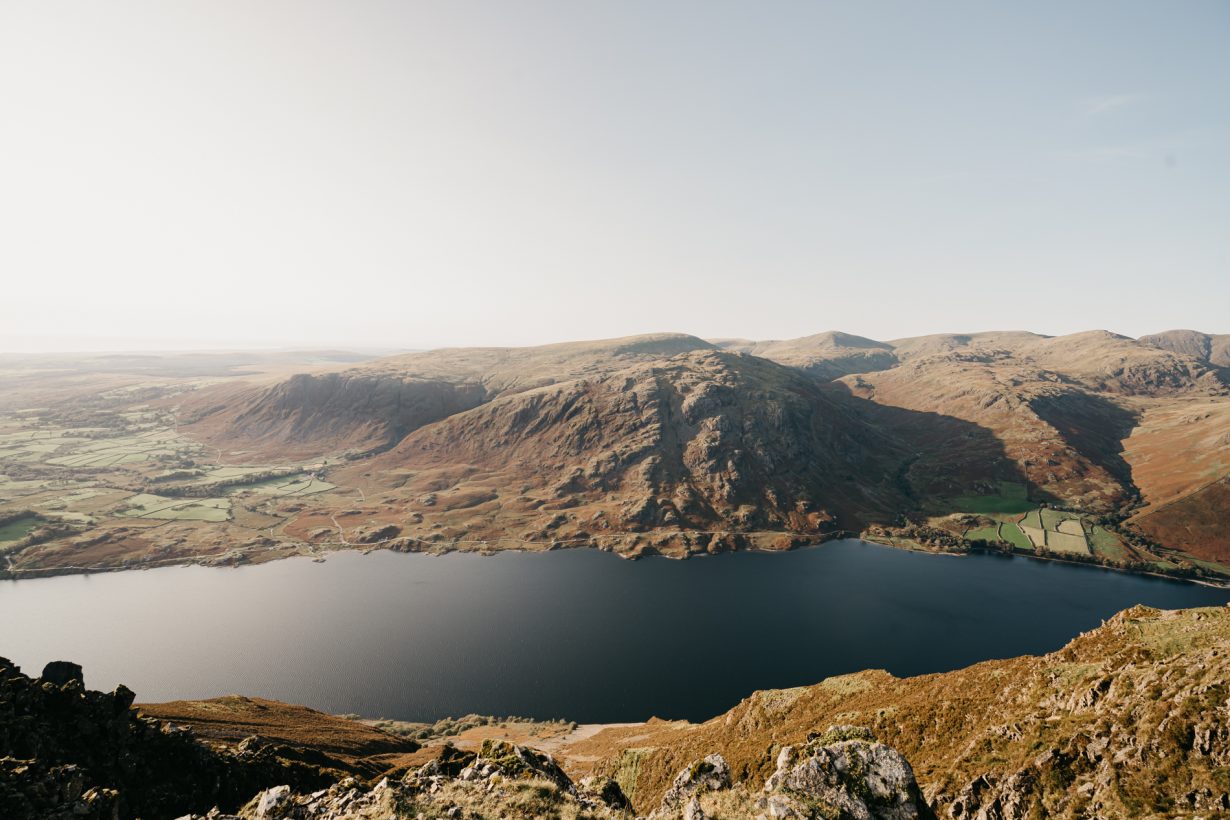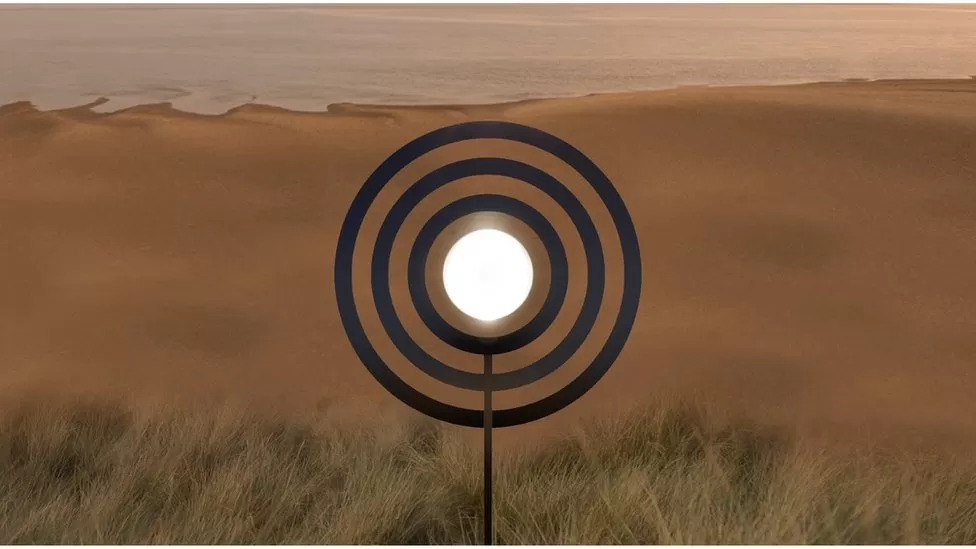NFTs – like land art – promise a bold new horizon, but can they ever provide a meaningful alternative?
NFTs might change the world, but not in the way you think. Two projects have recently been announced involving Olafur Eliasson – one virtual, the other rooted in a coastal landscape. At first they seem diametrically opposed to one another, but perhaps they might both have grown from the same old logic of extraction.
The first announcement is for a ‘new major landmark artwork’ on the west coast of England, part of a wider public programme entitled Deep Time: Commissions for the Lake District Coast. Conceived in collaboration with nature writer Robert Macfarlane, Eliasson’s proposal is for a ‘monumental outdoor artwork and optical illusion’. Your daylight destination would consist of an elliptical steel basin installed in the mud flats of Copeland, which, twice a day, at high tide, would be completely submerged by water, creating a reflective mirror-like pool of concentric rings. The second project, Your view matter is a virtual reality work and NFT – commissioned by Vignesh Sundaresan, aka MetaKovan, the crypto-currency billionaire who rose to fame last year when he paid $69.3m at Christie’s for Beeple’s NFT, Everyday: The First 5000 Days (2021) – consisting of a virtual journey among Platonic solids, which can be accessed online and is also being exhibited at various venues.

So, here goes: are NFTs the new land art? Your daylight destination is explicitly responsive to place, inspired by Cumbria’s prehistoric rock art to ‘unite earth, sky and ocean’; Your view matter, being virtual, is nominally placeless. And while the involvement of Macfarlane, who is currently working on a book about the ‘rights of nature’, suggests ecological sensitivity, the minting of NFTs points the other way.
But perhaps this apparent discrepancy in fact hints at a fundamental shared characteristic between land art – at least in its traditional forms – and NFTs. Whether grandiose and permanent or temporary and understated, all land art declares one thing – the right of the artist (often white and male) to take the land, wherever it may be, whatever its history, significance or current usages, and turn it into art. As William Malpas wrote in Richard Long: The Art of Walking (1995): ‘For the earthwork artist, the whole planet is an artist’s studio. The Nature artist ranges over the whole globe.’
In seeing the land as a site of discovery, incomplete until its own arrival, land art often treads a colonial logic. This is evident in Nancy Holt and Robert Smithson’s frontier Romanticism (and it is no coincidence that NFTs are frequently likened to the ‘wild west’). In creating Sun Tunnels (1973-76), for example, Holt identified herself with indigenous peoples while overlooking the violence of their erasure from the very land she had purchased to make the work. Lisa Le Feuvre, executive director of the Holt/Smithson Foundation, has recently promised to confront these questions.

The rhetoric around Deep Time is not dissimilar, albeit seen through the lens of tourism rather than settler colonialism. Copeland Borough Council’s Economic Development Manager, Sarah Mitchell, has described the forthcoming commission as a ‘landmark’ that will ‘help put our borough on the map’. It is notable that Deep Time has received funding not only from the UK’s Coastal Communities Fund (and is therefore compelled to repeat the former Prime Minister’s ‘levelling-up’ platitudes) but also from Sellafield power station, site of the country’s worst ever nuclear accident, where radiation was found to be leaking as recently as in 2019. While attention is directed towards photogenic land art, Cumbria is under consideration for a new geological disposal facility to house nuclear waste from Sellafield and other sites for the next few thousand years.
Like the picturesque, both NFTs and land art share an overemphasis on a single privileged perspective at the expense of all others. Eliasson’s land art proposal, for example, can only be viewed ‘at a specific distance and angle from a purpose-built circular viewing platform’. Eliasson’s titles, after all, emphasise the viewer’s experience above any wider considerations: your view, your destination. Likewise, most virtual artworks fail to confront the minerals, labour and energy consumption that makes them possible, instead privileging the experience of the viewer over the realities of production.

However, as media theorists like Jussi Parikka have pointed out, the virtual is predicated upon its materiality. The ecological destruction caused by cryptocurrency is well documented, as is the related fact that those suffering the most severe consequences of the climate crisis tend to be those least culpable and least economically equipped to deal with it. ‘The Merge’, Ethereum’s recent announcement of its shift from proof-of-work to proof-of-stake, has been hailed by enthusiasts as a solution to the vast energy usage needed for NFTs. But, as Everest Pipkin has argued, proof-of-stake rewards those ‘who are already bought in, who already have excess capital or access to outsized computational power’. Even after the much-heralded Merge, Ethereum continues to ‘grant power to the already powerful’. NFTs, therefore, like land art, surely cannot be a tool for environmental justice.
Once upon a time, land art promised a bold new horizon – the existence of art outside of sterile galleries and institutions. In reality, by creating new mediums and sites of productivity, land art did not challenge the system – it extended it. Likewise, if NFTs, heralded by advocates as a democratising force, were ever really a meaningful alternative, then that has not lasted long. Works by supposedly anti-commercial land artists have always also been commodities (Richard Long is represented by Lisson; Michael Heizer and Walter de Maria by Gagosian) while multiple established art world powers have joined the NFTs goldrush: from Jeremy Deller and Damien Hirst to Bonhams and the British Museum. Whether it’s installing 88 tons of concrete in a desert or contributing disproportionately to the climate crisis, land art and NFTs create massive material upheaval. But they almost never provide meaningful challenges to systemic inequities.
